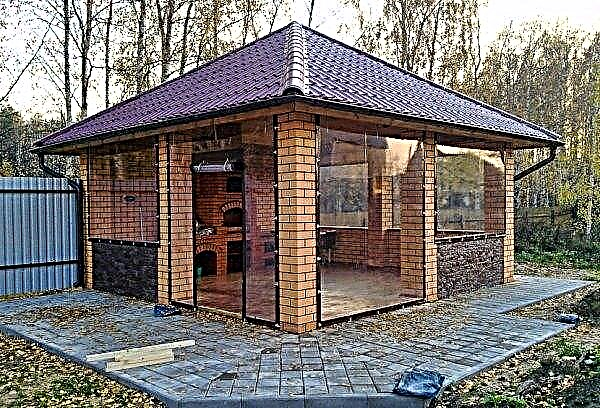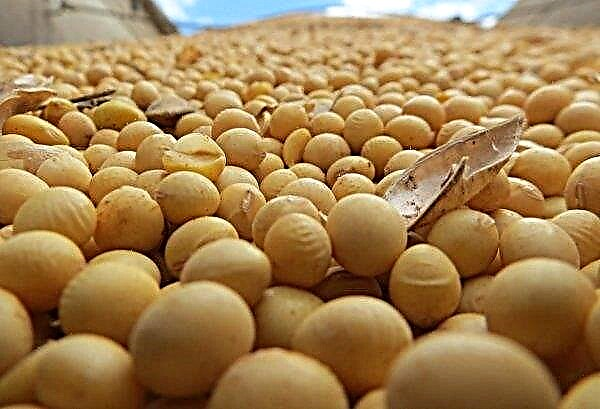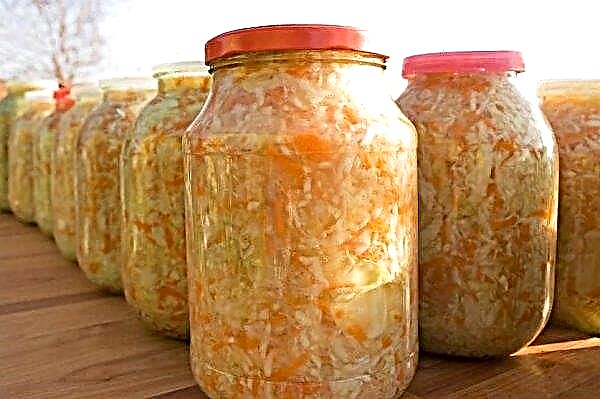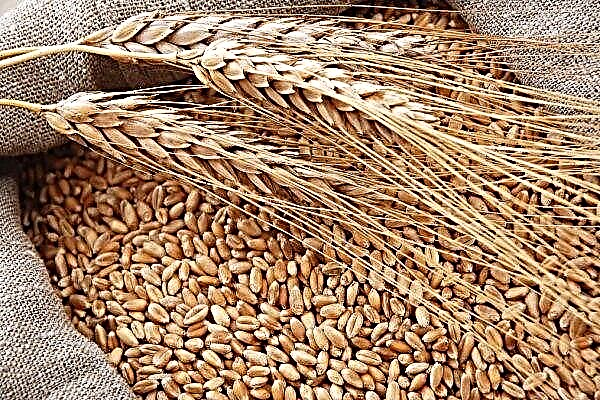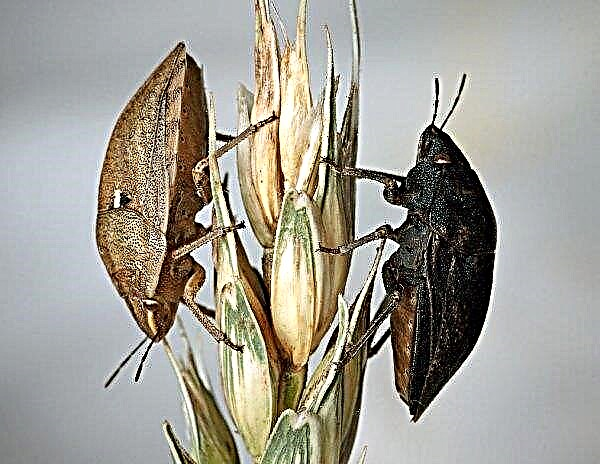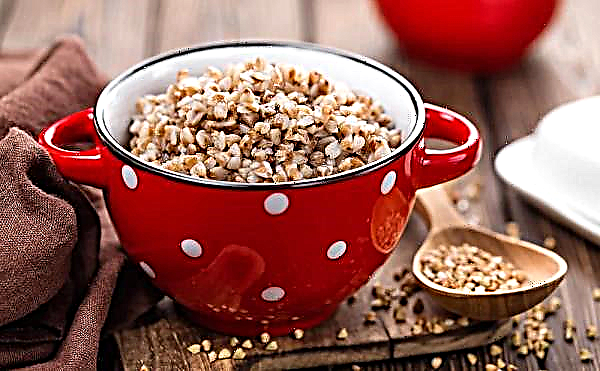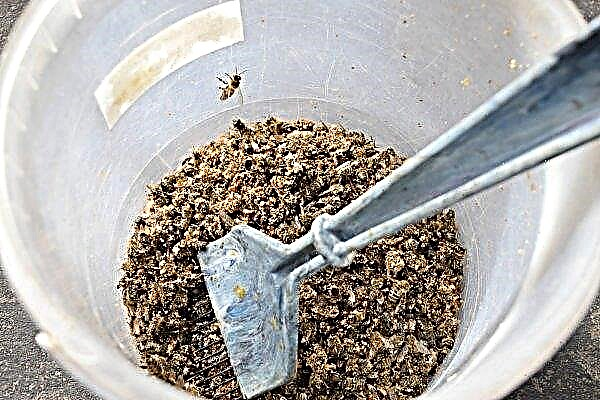In recent years, it has become fashionable to grow perennial conifers in indoor conditions. Such breeds have a high decorative effect, which persists throughout the year, does not require special growing conditions, but is a bit capricious in grooming. Among such crops, cypress is the most suitable exhibit for home. What are the characteristics of the plant, what are the necessary conditions for comfortable growth, and how it can be propagated - find out from the article.
Botanical description of the plant and its features
Cypress (Cupressus) is a coniferous monoecious perennial culture, which is characterized by the presence of a spreading or pyramidal crown, consisting of dense small shoots. The color of the needles of the plant, depending on the variety, varies from dark green to yellow-golden.
Unlike natural representatives, whose height reaches 30 m, indoor ones are smaller. The stems of the culture are soft, covered with numerous scaly leaves, the shape of which resembles an elongated rhombus. Leaf plates have a dark green color, giving a slight blue. The fruits of cypress are small cones of an egg-shaped appearance, covered with scales on top, under which small seeds are located.

Quite often, inexperienced gardeners confuse cypress with cypress, which is very similar to it, but has a different color of needles. However, caring for plants is similar, so if a cypress is at home, then this will not be an unpleasant surprise for a gardener.
Important! You can also cultivate the usual types of cypresses at home, but then you will have to prune the root processes annually.
Popular varieties
Florists today practice planting in indoor conditions, both cypress and cypress.
However, due to the large size of the latter cultivars, there are few:
- Evergreen. It has a spreading or pyramidal crown, red bark, small leaves collected in twigs of dark green color, tightly pressed against each other. In nature, it is able to reach a height of 30 m. Suitable for indoor breeding, as it is characterized by slow growth rates, drought-resistant and has excellent resistance to changes in temperature indicators.

- Large fruited. It is the most adaptable variety for home breeding. The tree has a dense crown in the form of a pyramid, an erect trunk, a large number of small branches, on which a lot of green leaves, covered with characteristic scales, are concentrated. For housing, experts advise using dwarf varieties of the Gold series, which have golden needles and a delicate aroma. One of these instances is lemon cypress - a small neat tree, characterized by the presence of a columnar crown, which with development becomes more spreading. It is quite easy to distinguish lemongrass from other varieties by its beautiful soft, thick light green or yellowish-green needles, which produce a pleasant, rich aroma of lemon.

- Moroccan. A fairly rare variety that is great for growing on the street, but many gardeners are trying to grow it in the apartment. The plant has a long, narrow crown, consisting of dense dense shoots on top covered with small green scaly leaves.
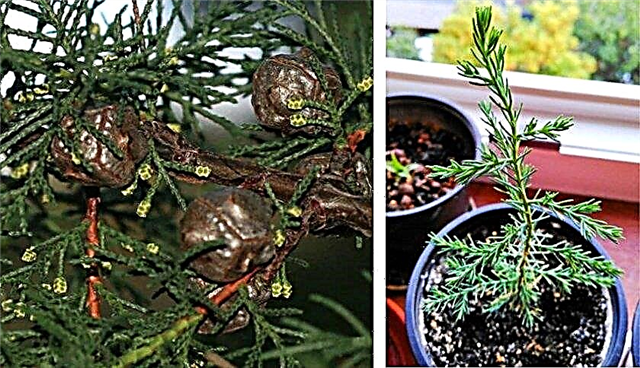
- Kashimir. This variety survives well in an apartment, adapts well to high temperature indicators, however, for its development it needs a properly selected soil and compliance with air humidity conditions.
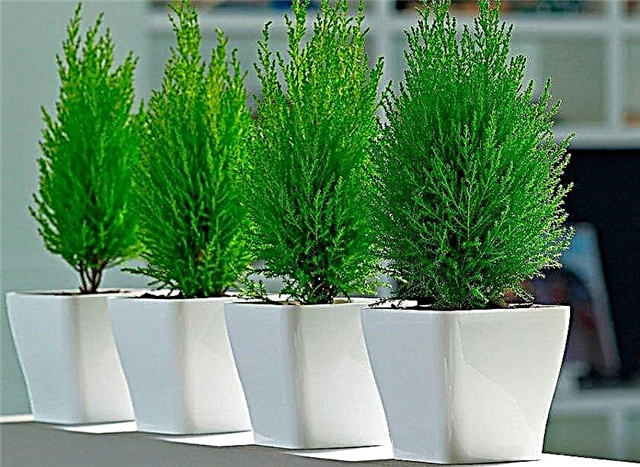
Planting a plant
Growing a coniferous plant at home is a responsible, difficult, but interesting occupation. In order for the tree to please for a long time with a high aesthetic appearance and decorativeness, experts advise to pay special attention to the process of planting it.
Did you know? Cypress wood has an extremely high strength and is practically not susceptible to insects. For this reason, in ancient times, iconostases were made of it, icons were painted. In ancient Egypt, sarcophagi were made from it.
Pot selection
When carrying out planting, it is important to choose a suitable tank. The volume of the container should be 3-4 cm higher than the size of the root processes of the culture. Mandatory is the presence of drainage holes in the pot, which will contribute to the release of excess water.
If drainage is not organized, then a plant with prolonged stagnation of moisture through rotting of the roots may die. A container made of clay is considered the best option: it will retain moisture in the summer, and in the winter - protect the root processes from cooling.

Preparation of soil and seedling
Properly selected soil is another important component of the successful growth of cypress spruce.. Planting is allowed in a shop substrate specifically designed for conifers.
You can prepare the soil yourself, the main thing is that it meets the following characteristics:
- good moisture permeability;
- breathability;
- friability;
- lightness and nutrition.
You can make a substrate for a perennial yourself by mixing sheet soil, turf soil, sand and peat in a ratio of 2: 1: 1: 1.
Video: Homemade Cypress
When choosing a cypress seedling, you need to pay attention to the following aspects:
- the needles of a healthy fresh plant have a rich green color, without yellowness, drying out and signs of disease. When carried along branches, the needles should emit a pleasant smell;
- on shoots, leaves or trunk there should not be insects, cobwebs, mold or other unnatural phenomena;
- the soil in the pot should be moderately moist. If the culture was watered too abundantly and often, then its root system may suffer from fungi.
Acquire a plant is advised in specialized stores or garden marketsthat can guarantee the freshness and quality of planting material.

Landing process
It should be remembered that the root system of cypress negatively refers to any intervention, therefore, the landing should be done carefully and accurately.
The landing process is based on the following steps:
Immediately after planting, the culture needs to provide a sparing regime that will allow it to quickly adapt to new conditions and take root. To do this, put the pot with a tree in a shaded place, reduce the number and frequency of watering.
Plant location
In places of natural growth of cypress, a humid and warm climate prevails, therefore, for the full development of the plant in the apartment, he needs to arrange approximately the same conditions.
Place lighting
Cypress prefers well-lit places, but protected from direct sunlight, which have a negative effect on the state of needles. The optimal location of the perennial is considered window sills in the northern or eastern part of the house. You also need to ensure that the container with the plant is protected from drafts, which can cause various diseases.

In winter, when there is a lack of sunlight, the culture should be additionally illuminated using traditional fluorescent lamps or phytolamps.
Important! Lack of lighting negatively affects the decorative effect of cypress: it is pulled up, too thin, loses its saturated color.
Temperature
Cypress refers to seasonal plants that require a certain temperature at different times of the year. In the summer, the perennial prefers heat around + 20 ... + 25 ° С, and in winter - it is cool, about + 8 ... + 15 ° С. To bring room temperature indicators closer to natural, in winter it is recommended to place a container with a plant on a loggia or insulated balconyAt the same time, insulate the pot to protect the root system from frostbite.
Extremely detrimental to conifers is the location near the heating radiators. Under such conditions, they can dry completely, without the possibility of recovery.

Humidity
In summer, when the weather is predominant, the conifer should spray in the morning and evening using standing water. The use of chlorinated, non-filtered water will result in a white coating on the needles and soil. With low humidity, the plant begins to fade, dry out, lose its decorative effect.
It is useful to place a container of cypress on a stand, which is placed on a pallet. Excess moisture will evaporate from the tray, moisturize the needles, while not contacting the root processes. If the humidity level is insufficient, experts recommend using special air humidifiers or placing decorative fountains, an aquarium with fish, and a regular tank of water near a container with a perennial.

Cypress Care
Despite some demands on growing conditions, it’s easy to care for the perennial. The main thing is to timely and regularly carry out basic agricultural practices, which include irrigation, top dressing, pruning, professional treatment from ailments and pests.
Watering
As noted above cypress is a seasonal crop that requires frequent watering in the summer and infrequent in the winter. At high temperatures in the range + 20 ... + 25 ° С, the plant is moistened 2-3 times a week. In spring and autumn, at a temperature of + 12 ... + 15 ° C, the frequency of irrigation is reduced to once every 7 days. In winter, when the thermometer readings are at + 8 ... + 10 ° С, irrigation measures are carried out once every 10-14 days.
When moistening the tree, it is necessary to ensure that the soil in the pot is always slightly moist. It is this landmark that should serve as an impetus for the implementation of perennial irrigation.

Fertilizer
Dressing cypress, grown at home, is aimed at preserving and improving the decorativeness of the plant, to maintain its optimal size.. Since the culture in winter is at rest, it does not need any additional feeding.
The fertilizer application is carried out from early spring to autumn.
Did you know? Cypress is a long-lived plant. On average, the life span of a culture varies from 2,000 to 5,000 years.
The perennial recharge scheme looks approximately like this:
- in spring, the tree is sprayed with a preparation based on iron, for example, Ferovit, and watered with a growth biostimulator - Zircon or analogues;
- throughout the spring-summer period, the plant is fed with complex mineral fertilizers intended for coniferous crops: “Green Needle”, “Florovit”;
- in the summer, twice a month they spray the conifers with mineral fertilizers for leaf and root feeding, for example, Agricola, Zdraven.
 It is forbidden to apply any top dressing if parasites are found on cypress or there are signs of fungal diseases. All drugs are diluted according to the instructions and used in authorized dosages.
It is forbidden to apply any top dressing if parasites are found on cypress or there are signs of fungal diseases. All drugs are diluted according to the instructions and used in authorized dosages.
Pruning
Despite the fact that cypress has a slow growth rate, its height increases every year. In order not to grow a huge tree in the apartment, the plant should be pruned regularly by conducting a shaping, curly or supporting haircut.
So that the perennial does not grow up, it is recommended to cut the roots when replanting and completely remove the extra branches. Pruning activities are carried out in spring, while old, dry, diseased shoots are removed, young ones are shortened in the shape of a crown (pyramidal or spreading).
The first forming pruning is carried out no earlier than a year after planting. With each procedure, young shoots are pruned no more than 1/3 of their length.
Trimming involves creating an unusual shape, for example, a round ball, cone or spiral. Spend it with special scissors that are pre-disinfected.
Diseases and Pests
Cypress has excellent immunity, rarely exposed to diseases or pests.
Health problems in a plant can occur due to improper care:
- excessive soil moisture, which leads to rotting of the roots and damage to fungal diseases;
- lack of lighting, which provokes yellowing of the needles and its further shedding;
- deficiency or lack of nutrients, which can also contribute to the development of fungi;
- non-compliance with the temperature regime, as a result of which the plant becomes sluggish and turns yellow.

You can solve the problem by properly organized care. Cypress should be transplanted into a new substrate and provide him with the necessary, close to natural, living conditions.
Of the pests, the greatest danger is:
- scale shield;
- false shield;
- spider mite.
Parasites feed on perennial juice, because of which it fades, dries and withers. An effective method of combating insect pests is spraying with the Aktellik insecticide (2 ml of the product per 1 liter of water). After 7-10 days, the treatment is repeated.

Simple preventative measures allow you to prevent the development of diseases and the appearance of parasites:
- strict control of soil moisture;
- compliance with temperature and lighting;
- regular pruning;
- systematic "airing" of the tree in the fresh air.
Breeding methods
At home, flower growers practice several effective methods of breeding cypress: seeds, cuttings. The latter is considered the most simple, affordable and often used.
Seeds
By the seed method, the plant is propagated in spring. For this, seeds are carefully extracted from the green, opened cones. Usually each fruit produces about 30 grains, while experts advise sowing everything in order to choose the strongest from the sprouted seedlings.
Soil intended for coniferous plants is poured into the sowing tank, after mixing it with sawdust and sand. Seeds are laid in the substrate, the soil is moistened, and the container is covered with a plastic film to create a greenhouse effect. Crops are placed in a shaded place and kept until the first sprouts form. When the seedlings appear, open the container, transfer it to a lighted place. Sprouts are watered as the topsoil dries. As soon as the seedlings reach a height of 5 cm they are planted in separate pots.

Cuttings
As a stalk, it is allowed to use any lignified shoot from which the lower leaves are cut, or an apical shoot, about 10 cm long. After the cut, the stalk is dipped for a day in any root formation stimulator intended for coniferous crops. At the end of the allotted time, the shoot is washed with clean water, the place of cut is treated with charcoal.
Next, the cuttings are carried out according to the algorithm:
- soil for conifers is poured into the tank;
- cuttings are immersed in soil at 1/3 of the length;
- water is abundantly watered, the container is covered with plastic wrap to create the effect of a greenhouse;
- every two days, the shelter is raised, the seedlings are aired, the soil is moistened with a spray gun.
Usually, rooting of cuttings occurs 2-3 months after planting in the ground. Rooted seedlings are planted in separate containers and provide them with care, like adult plants.
 Breeding by cuttings is best done in April, so that the plant can take root by the summer season and adapt well in warm climates
Breeding by cuttings is best done in April, so that the plant can take root by the summer season and adapt well in warm climates
Indoor cypress is an amazingly beautiful, noble and majestic plant that can decorate an apartment, house or office with its spectacular, amazing appearance. In addition to the aesthetic function, the culture is very useful because it is able to absorb harmful substances, purify the air, fill the room with a fresh, pleasant coniferous-lemon aroma.





